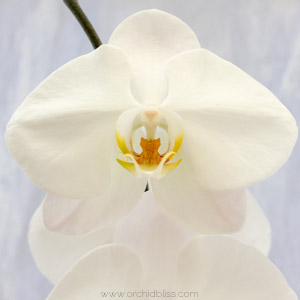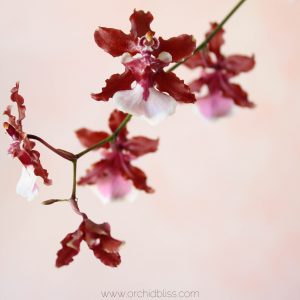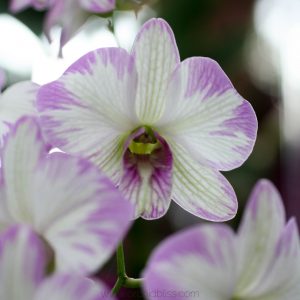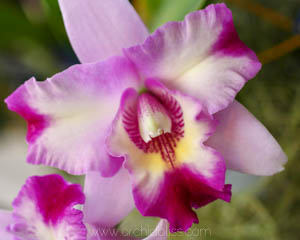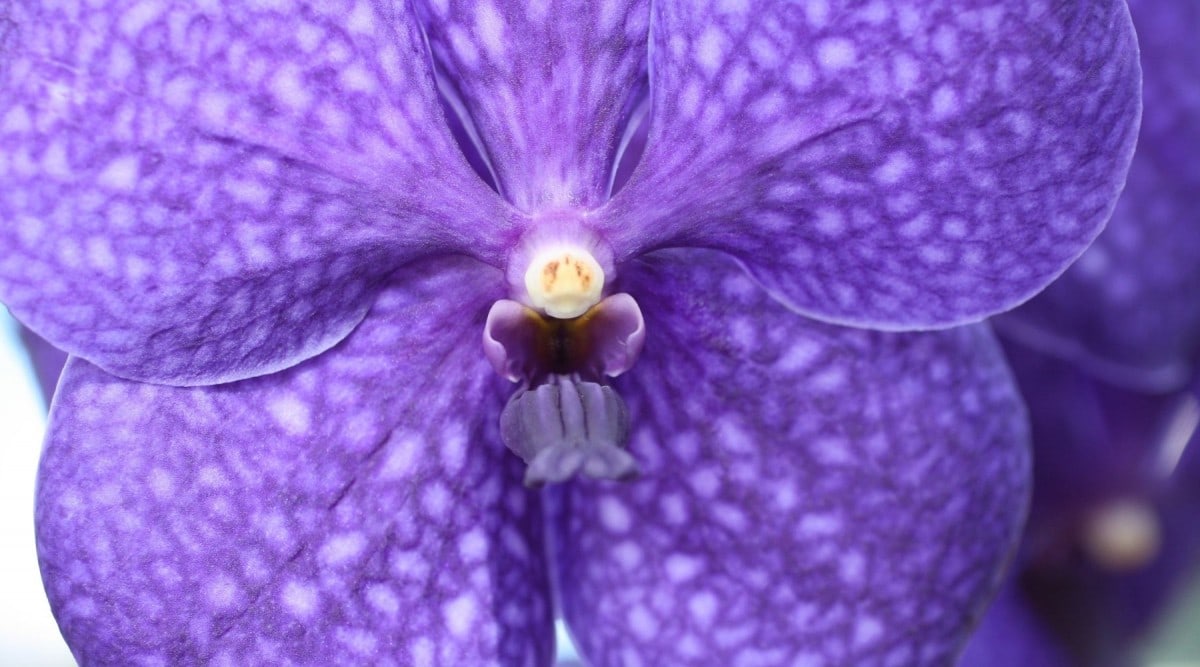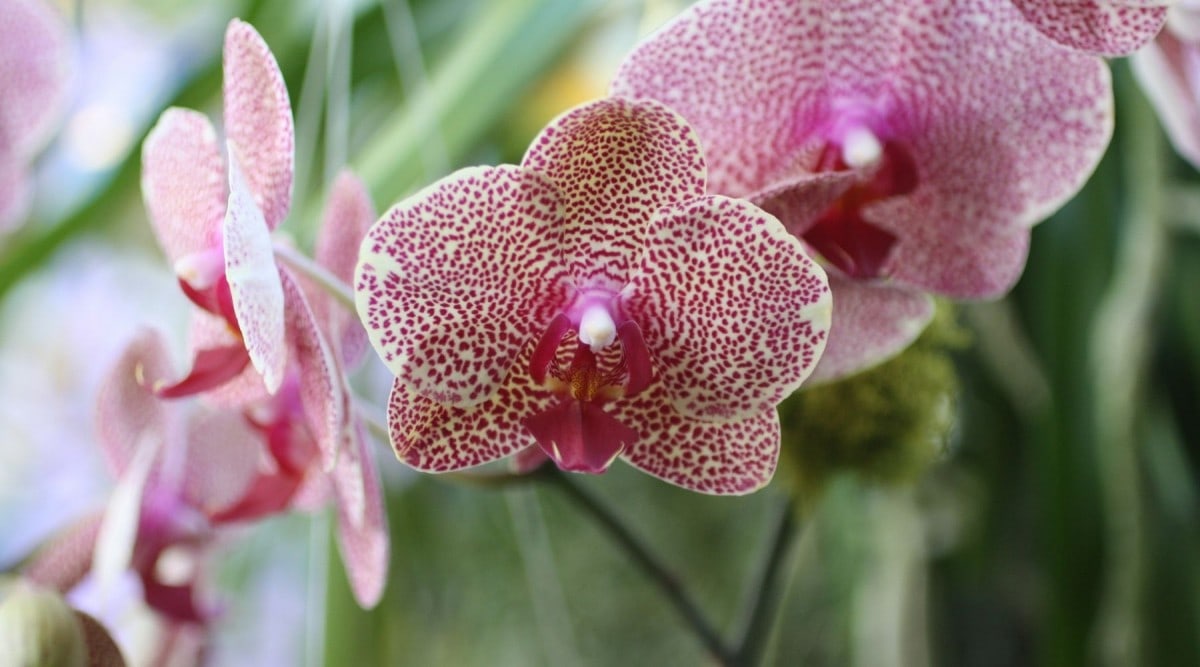
Have you received an orchid as a gift but don’t know how to take care of it? You can’t take proper care of your orchid without knowing its genus and species and thus its needs and features. You should know how to identify orchids so that you know what it needs.
To identify orchids, you should know the basic anatomy of the plant. The shape and color of the flowers, stems and leaves help you decide what species you have. Wild orchids are also recognizable by their natural habitats, shapes, colors, and numbers of leaves, spikes, and flowers.
In this article, you’ll learn how to identify common cultivated and wild orchids with or without flowers. We’ll also go through some basic terms related to the anatomy of orchids.
How to Identify Orchids Based on Flowers
Orchids are among the broadest plant families with more than 28000 species around the world. It’s practically impossible to give a thorough account of all species. But some orchid species are more widely present on the market, and you’re more likely to come across them in a shop.
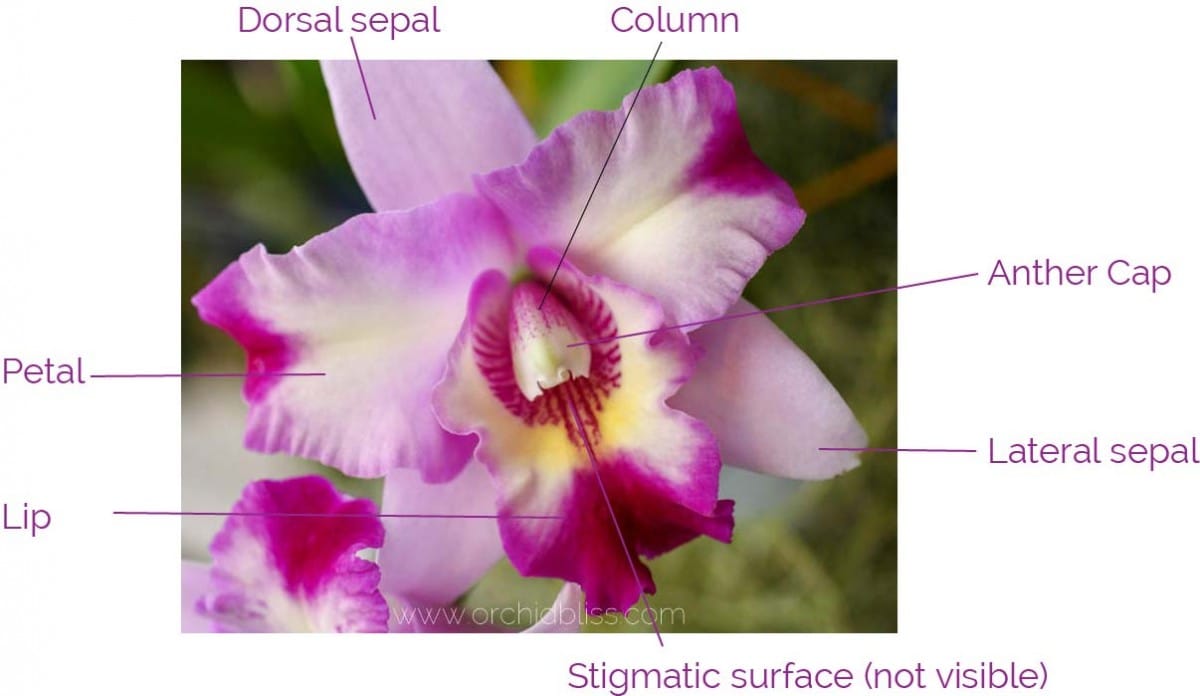
Look at the Flowers
The most common way to identify orchids is by looking at their flowers. Different genera of orchids have idiosyncratic flower shapes that help you recognize the species. Here’s what you should look for:
Size and Color
Orchids vary in flower size, ranging from an inch to several inches. Different parts of the flower, such as petals, sepals, and lips, also vary depending on the variety. Some orchids have mini versions, which help you narrow down your options.
As for the color, although most orchid species come in a wide range of colors, looking at the color, patterns, and streaks can be a good basis for judgment. Some are completely unique, like blue, while some are common among most species, such as white.
Shapes
One of the most important defining signs for orchids is the flower shapes. The way different parts of the flower, such as the column, petals, sepals, and spurs, are arranged can significantly help you identify the orchid. Some orchids have highly idiosyncratic flower shapes that have been the basis of their naming. The whole flower’s position is also important, with some flowers being pendants and others being upright.
Number
Each spike can bear different numbers of flowers in different orchid varieties. Some varieties grow one flower per spike while others bear more than 20. The number of flowers affects the way they’re arranged on the spike, too. With higher numbers, the flowers tend to grow in pairs, one at each side of the stem.
Common Orchid Species Flower Specifications
Based on what we said in the previous section, here are some of the most common orchids and how you can identify them based on their flowers:
Brassavola
Brassavola orchids are among the most common and easiest orchids to grow and widely available on the market. The fragrant flowers are pure white or greenish and grow individually or in small clusters.
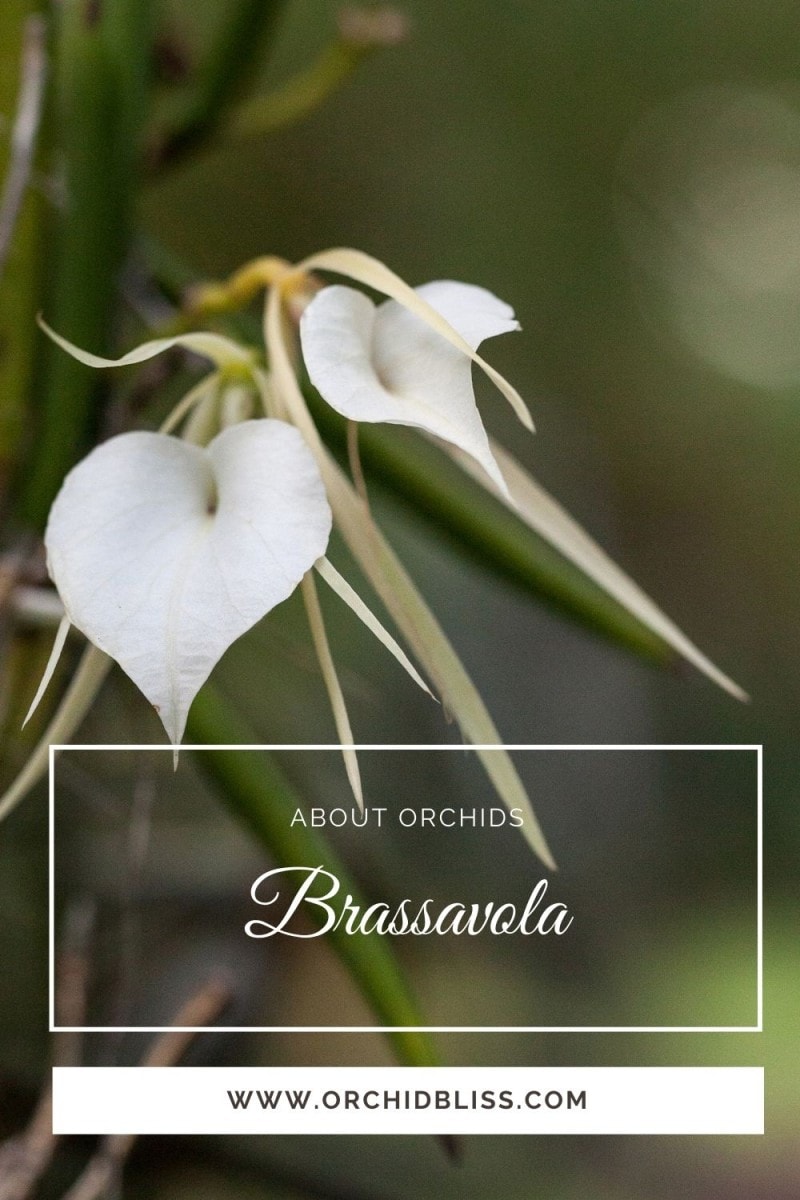
The star-shaped blooms are between 1 and 5 inches (2.54 – 12.7 centimeters) wide, with three long, narrow, and pale green petals. The flower’s lip is broad, and in some species, it’s fringed. The terete succulent leaves grow along a central rhizome that produces flowers in the winter.
The flowers can also be yellow with brown spots. The sweet citrusy scent attracts moths at night, like the Angraecum. The lip is large and resembles a scoop with petals that look like spears.
Commonly known as ‘lady of the night,’ it produces flowers that last between 5 and 30 days. They frequently bloom throughout the year and make up for their small size by flowering all-year-round.
Cattleya
These fragrant flowers can grow up to 8 inches (20.32 centimeters) wide, with ruffled edges. The lips are usually large, and the flower’s center has a contrasting color to the flower. There are different hybrids of cattleya. That’s why it comes in a wide array of colors, including various shades of white, yellow, purple, pink, orange, and red.
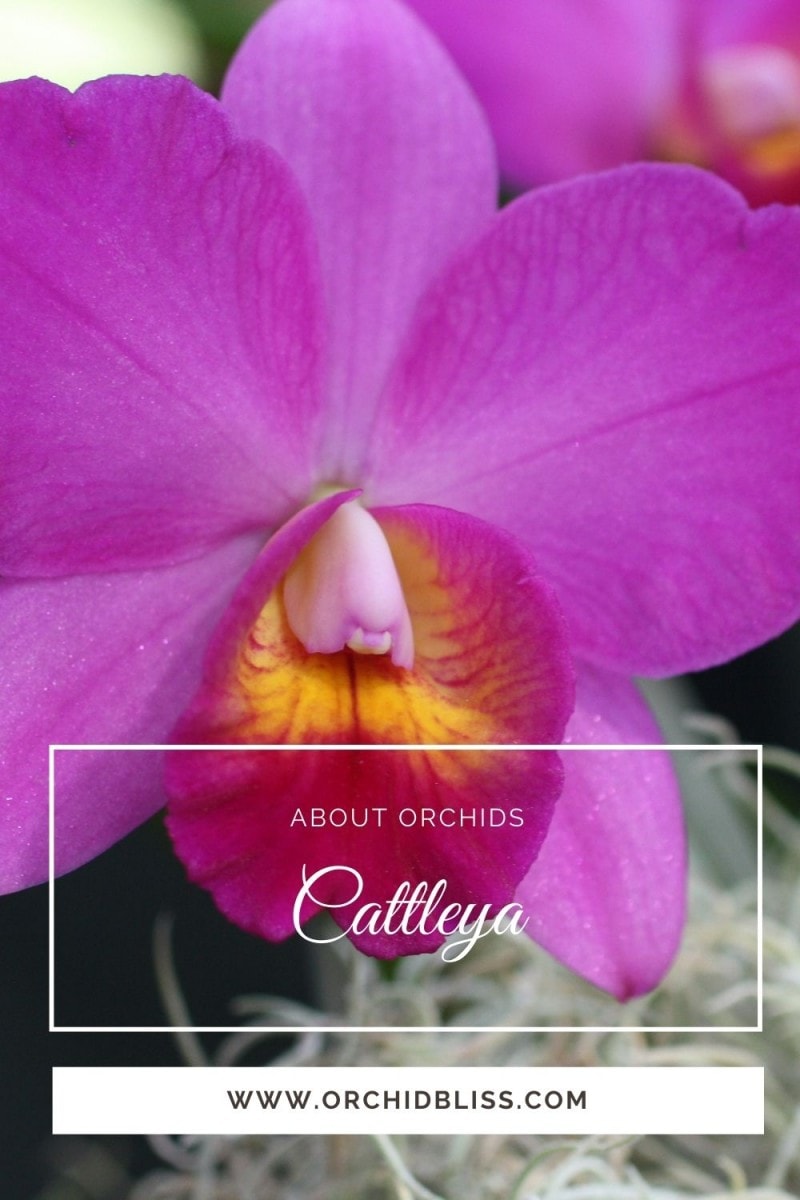
There’s also a miniature type of cattleya, half of the standard cattleya’s size, less than 8 inches (20.32 centimeters) tall. The flowers look exactly like regular cattleya’s blooms, only smaller.
Dendrobium
One of the broadest orchid families is dendrobium, with about 1800 species as diverse as their natural habitats and growing conditions. The flowers are green, purple, red, or pink. The sepals and petals are similar but completely different from the lips.
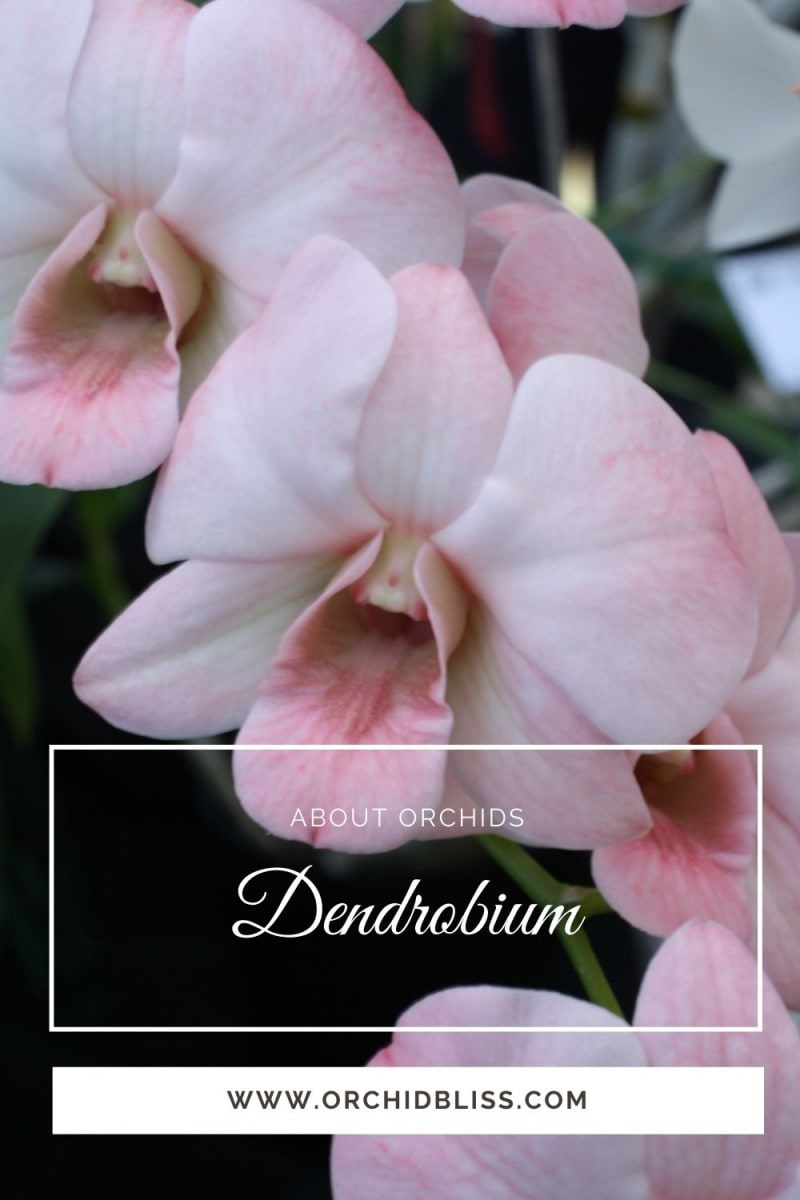
The spikes on dendrobium are as varied as the species, sprouting from different locations. For example, they grow in the middle of the cane, or stem, and on its sides. In the two most common dendrobium species, Dendrobium phalaenopsis and the Dendrobium Nobile, the flower spikes grow from the middle and along with the cane, respectively.
The dendrobium phalaenopsis has a spur at the lip’s back. The stems can be completely upright or a little bent. Interestingly, old canes can bear flowers.
Dendrobium’s roots aren’t good signs to identify them. Some species have aerial roots while others grow in soil.
Oncidium
With over 700 species, oncidium flowers usually come in yellow with brown hints. The wide range of species results from the flower’s easy pollination with other species, creating a whole range of hybrids. The cascade is downward and grows up to 6 feet (1.83 meters) long. The flower’s lip is large, making a large lower petal, where insects stand as a landing place when pollinating.
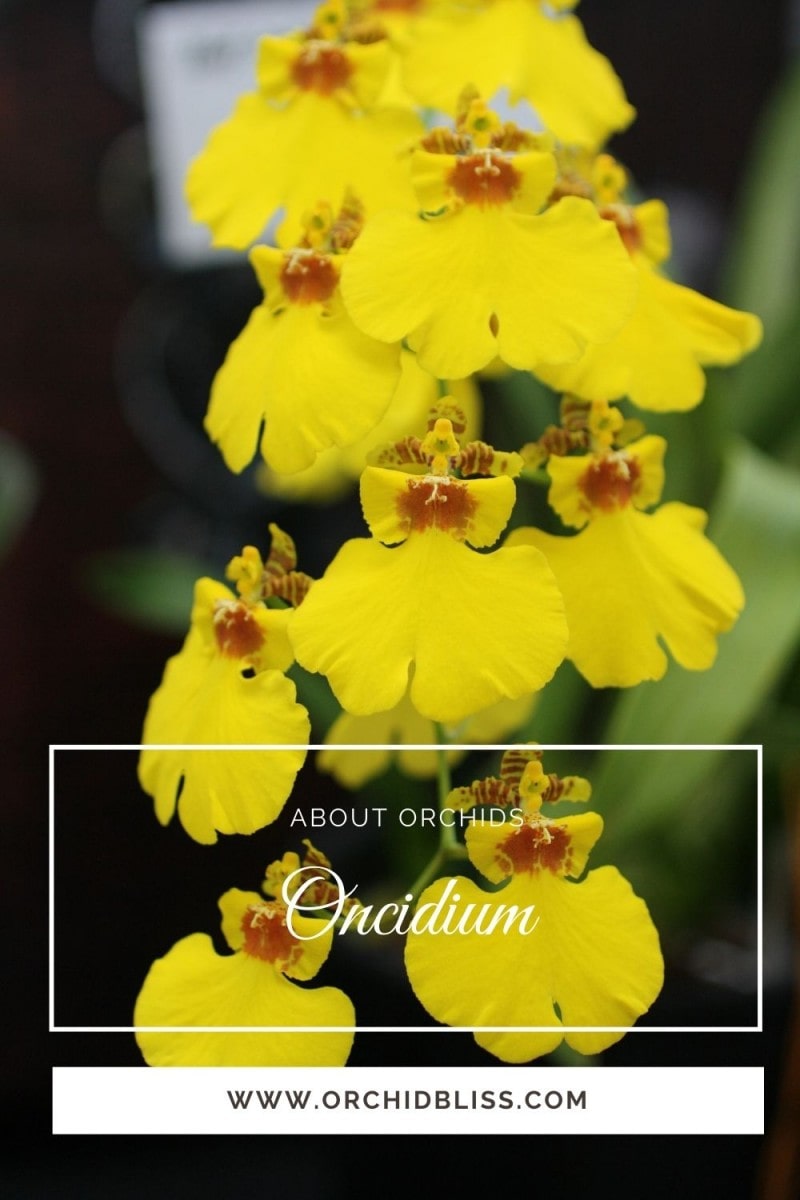
The pendant flowers come in an overwhelmingly large array of shapes and sizes. But they’re generally small to medium, growing on a Christmas-tree-shaped stem. The most easily identifiable oncidium is the dancing lady with a bright yellow color. But other species come in different colors like yellow, red, pink, white, and a combination of these colors.
There’s also another genus that used to belong to the oncidium genus, called equitant oncidiums. Now they have a distinct genus called tolumnia since they’re entirely different from oncidium.
For one thing, they’re smaller than oncidium. The leaves look like fans with a fleshy texture and dark reddish-green color. If you cut a leaf with a knife, you’ll see a triangular cross-section. The spikes are long and grow from the plant’s base. Each spike bears several small flowers resembling the oncidium dancing lady.
The pseudobulbs are the defining features of this orchid with their round and circular and wrinkly shape that may look old or dehydrated. But there’s no need to worry since it’s the typical feature of this type.
On each pseudobulb, oncidiums grow one to four leaves. The flower spike is initially one of these leaves that later reshapes into a spike. Several flower spikes can grow from each pseudobulb’s base.
The most famous oncidium variety is the sharry baby, with its peculiar chocolate-like scent. Oncidium also has miniature types with similar characteristics as the common species. The only difference is that the miniature variety doesn’t grow out of the pot.
Paphiopedilum
It’s a terrestrial orchid commonly known as the lady slipper. The name comes from its native land, North American Wetlands, where native Indians called it a woman’s moccasin. The flower has a distinctive shape with a pouch-like lip looking like a slipper’s toe. The flowers are long-lasting and bloom once or twice a year.
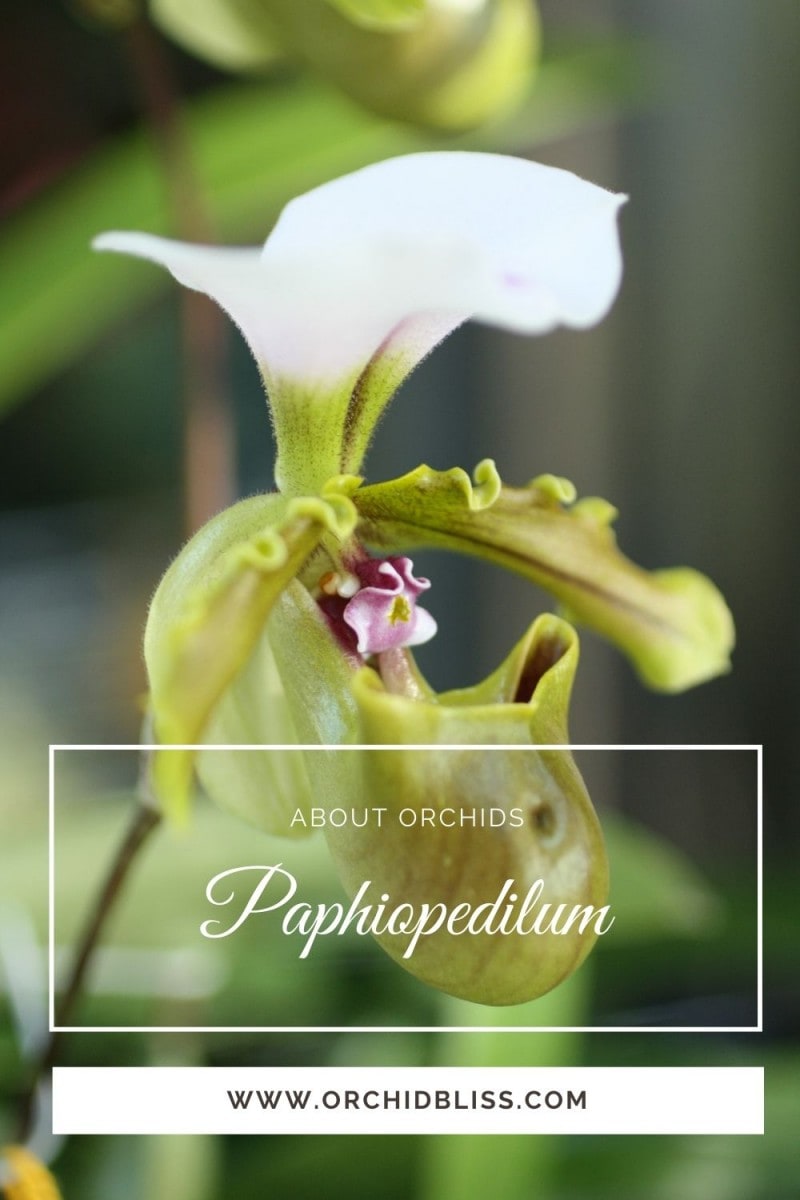
The flowers grow one at a time and on the spike that comes from the center.
Phalaenopsis
These are the most common orchids commercially cultivated with flowers that last up to three months. They’re perfect for beginners since they’re easy to grow.
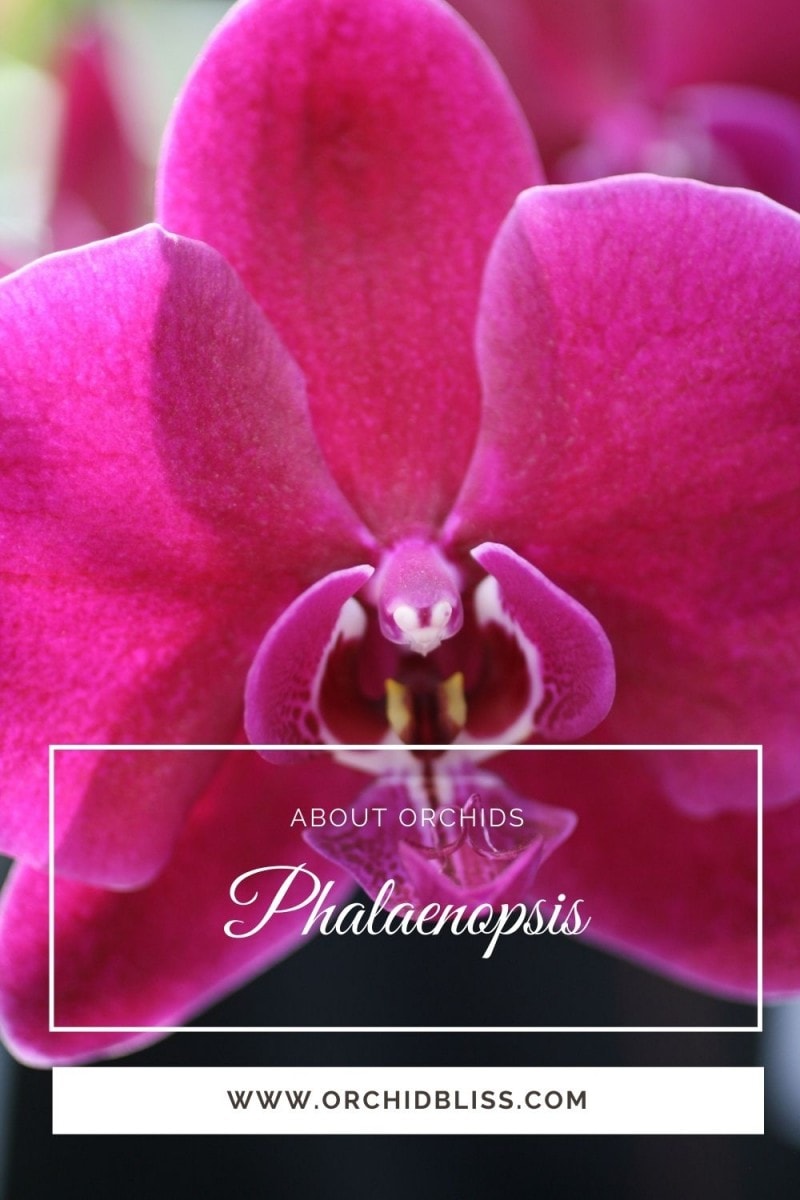
Its common name is moth orchid since the name contains the Greek words phalain, meaning moth, and opsis, meaning appearance. It got its name because it resembles the tropical white moths.
Each plant produces one flower spike that comes from the central stem. The flowers are large and distinctive, and they come in a whole range of colors, from pure white, red, and orange to unique spotty harlequin with dark maroon speckles and marbled patterns. Some species have purple, pink, and orange pastel shades.
One of the most striking varieties is the phalaenopsis Bellina with pointed petals that are purple in the center and pale green on the edges.
If you want to know where to cut your orchid’s flower spike, start by downloading my free cheat sheet to see where to cut the orchid flower spike after blooms have faded to trigger re-blooming. Click here, for the cheat sheet. It’ll be super helpful.
How to Identify Orchids Without Flowers
You can also identify orchids based on their other characteristics. Many species have distinctive leaves, roots, and pseudobulbs that help you identify the orchid.
Look at the Features
Look for the following features to know what orchid you have:
Leaves
The most helpful tool for orchid identification after flowers is the leaves. The leaves’ shapes are the direct result of the plant’s natural habitat. For example, orchids that live in drylands tend to have succulent leaves that retain water and moisture for longer periods.
Leaves can come in different shapes and colors. Some are long and pointy, while others are round.
Look for the number of leaves and where they appear. Some orchids have one pair of leaves per spike, while others are bushy with lots of leaves.
Roots
Orchids’ roots vary depending on the medium they grow in. Some of them are aerial, which means they get nutrients from the air and don’t grow in soil; others are terrestrial, so they have to grow in soil.
The root shapes are also different; some orchids have coiling roots, while others have straight roots.
If limp orchid leaves are a problem for your orchids download my free cheat sheet on how to prevent limp leaves and rotten roots. Click here for the super helpful cheat sheet.
Pseudobulbs
Pseudobulbs are water storage organs that form as thickened parts at each growth’s base. In different orchid varieties, pseudobulbs have different forms. They can have leaves or bracts along their length or have a pair of leaves at the top. They can be thick or thin, round or star-shaped. Orchids that hail from drylands are more likely to develop pseudobulbs.
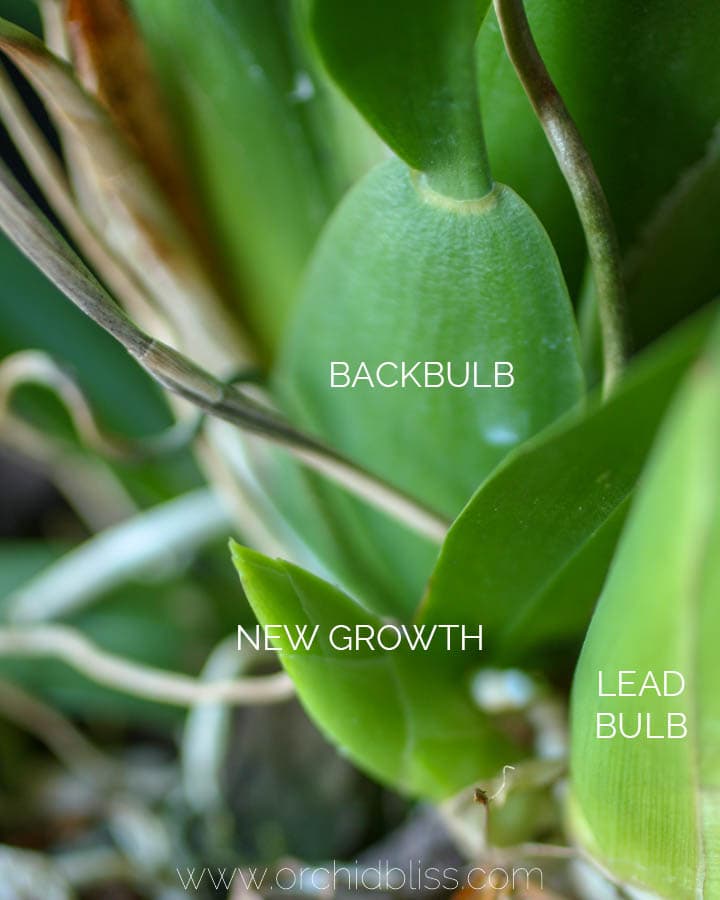
Common Orchids Specifications Without Flowers
Here are some of the most common orchids without flowers and how you can identify them based on their features:
Brassavola
You can identify the brassavola because the leaves of these orchids are long and tubular and can grow up to one foot long and sometimes can be unrolled and flat. Since the pseudobulbs are small, the leaves look like they sprout from the rhizome, not the pseudobulbs.
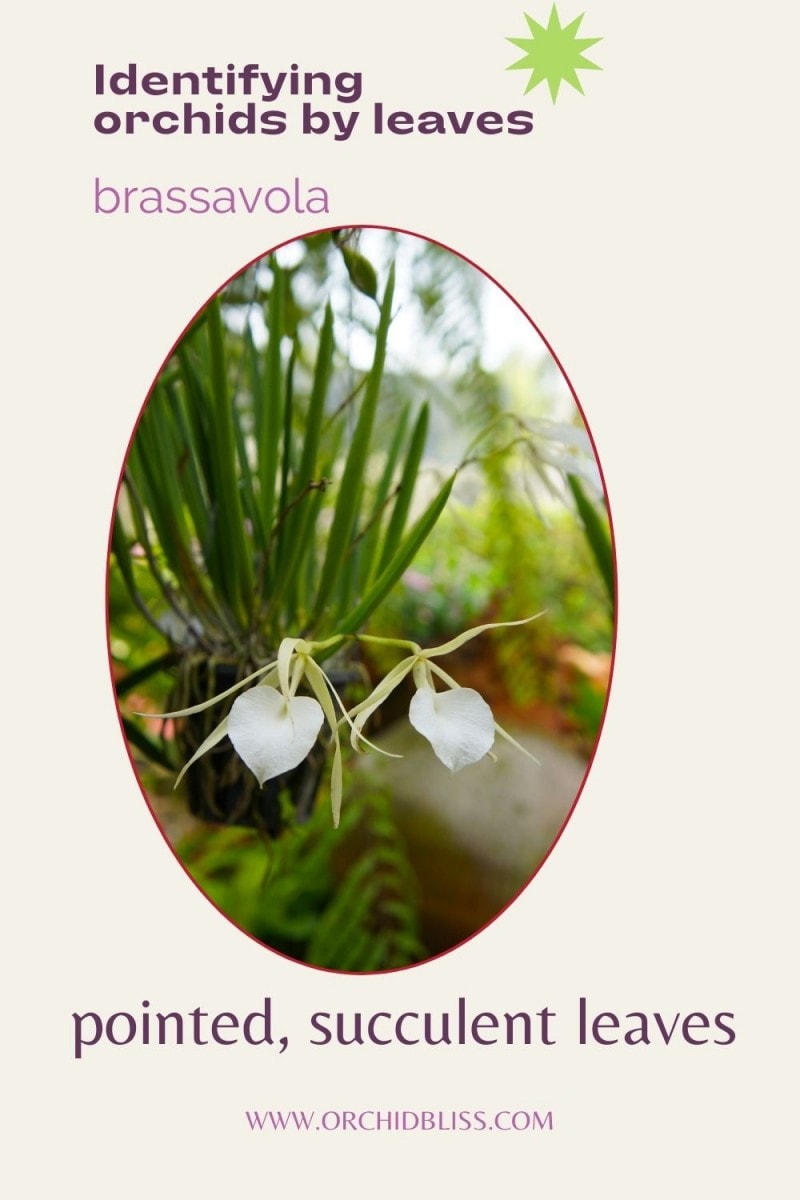
Cattleya
The hard and waxy leaves grow on thin pseudobulbs connected through a horizontal section under the rhizome.
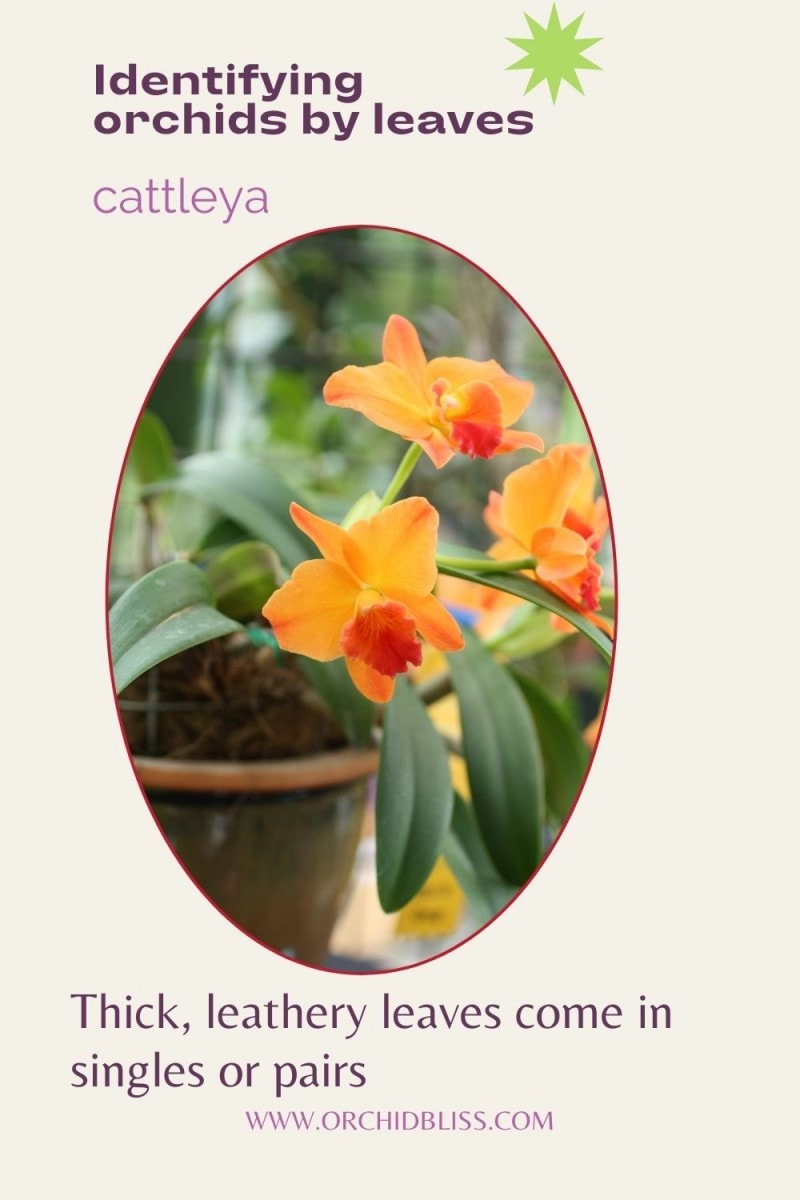
The flower stem’s bottom is the key to identifying cattleya. It’s sympodial, which means that cattleya has five or six ones, unlike most orchids with only one central stem. Each stem can bear flowers and has a few leaves at its end.
There are only one or two leaves at the end of the pseudobulbs, which might lead one to think it doesn’t have many leaves. But since there are many pseudobulbs, it looks nothing like what you have in your mind. It fills out the potting and spreads in different directions.
Unifoliate species bear one leaf per pseudobulb, while bifoliate species produce a pair of leaves per pseudobulb.
You can’t see the rhizome because it’s hidden under the potting medium, with roots and pseudobulbs emerging from there. The pseudobulbs aren’t readily noticeable, located at the bottom of the stem looking like wheat.
The miniature cattleya’s pseudobulbs are also the same as the standard cattleya with the same growth habits.
Dendrobium
The pseudobulbs, which are long and slender, could be confused with the stems. There are several canes and more than one main stem. The leaves grow along the cane opposite each other.
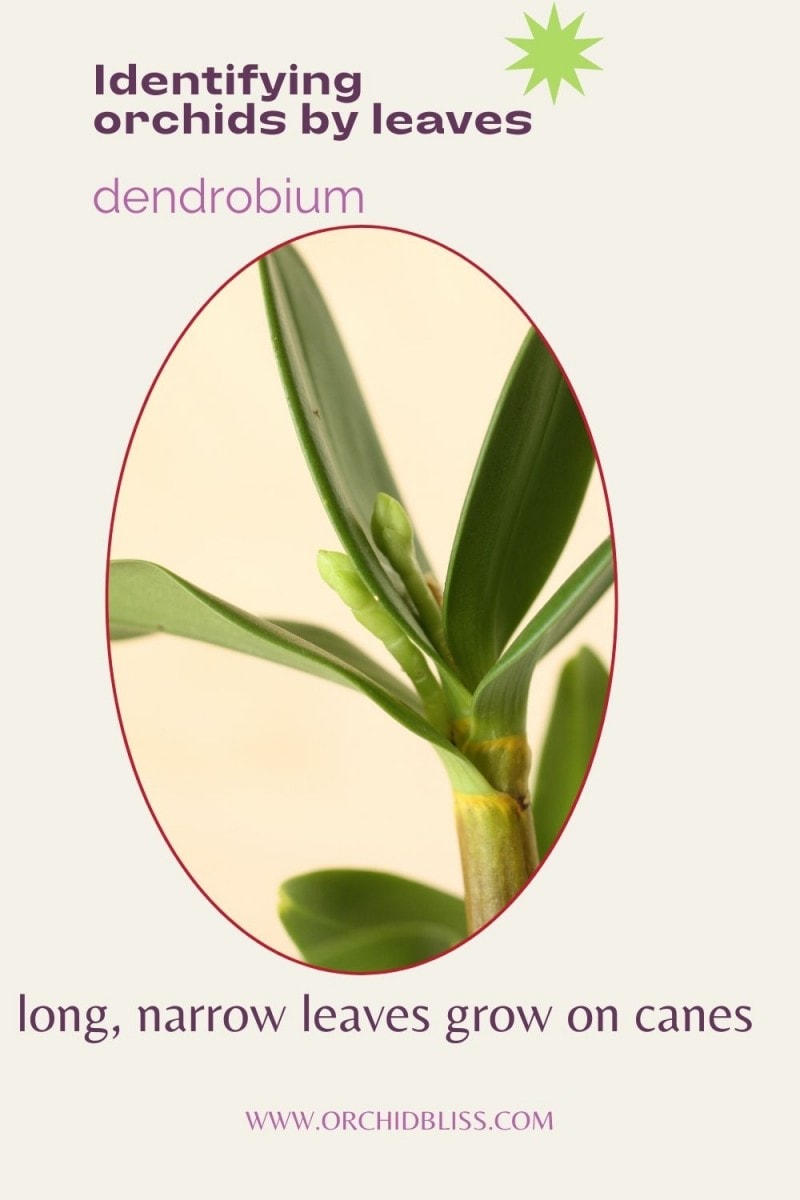
The leaves on all species are long and narrow. Depending on the species, the thickness and toughness of leaves vary. For example, dendrobium phalaenopsis has thick leaves that break off if you bend them. But Nobile dendrobium has long, slender leaves that bend easily.
Unlike other types of orchids, dendrobiums may be less attractive without flowers, and they can even look unsightly during their resting period. They may lose their leaves during this period, but they regrow after the resting period is over. The flowers are colorful, flat, and round, covering the stem entirely in large numbers.
Paphiopedilum
Since the leaves sprout from the roots, they’re not very long and stay close to the ground. Although they’re sympodial, paphiopedilums don’t have pseudobulbs. Each “fan” of the new leaves grows out of the previous one.
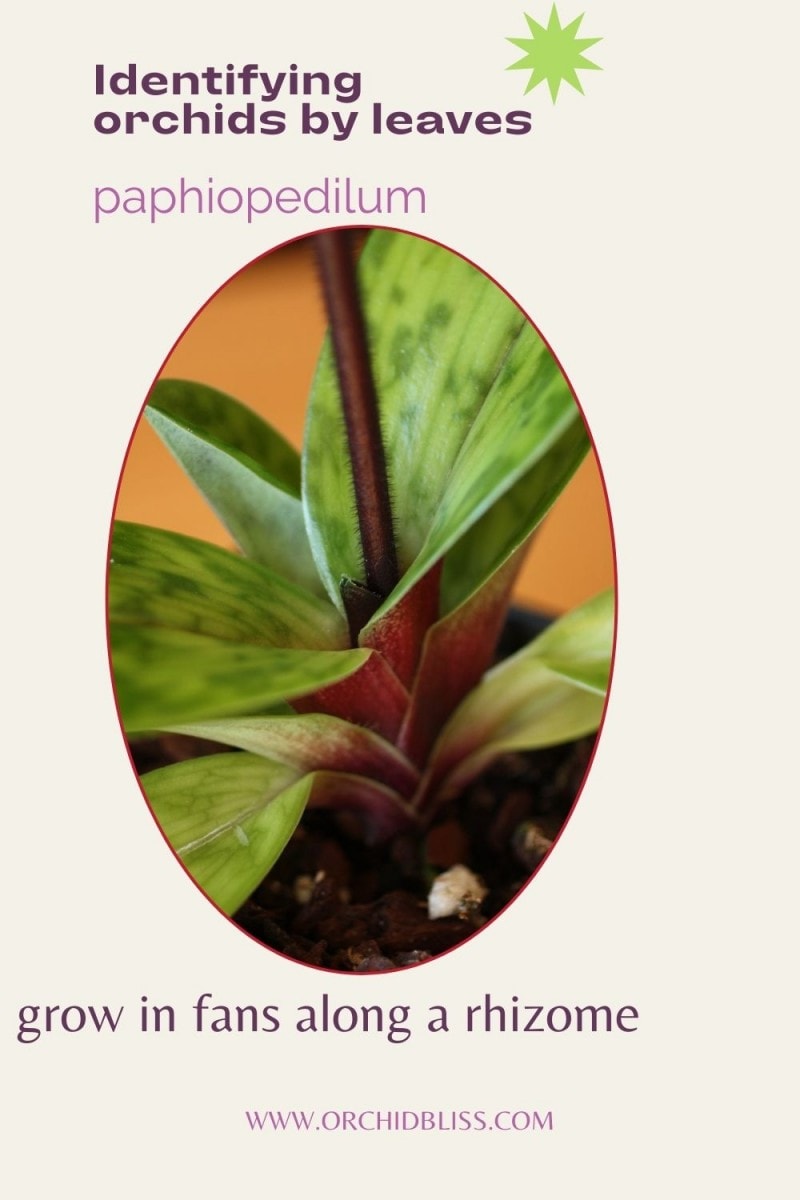
Another way to identify the paphiopedilum is its tiny rhizome and lack of aerial roots. They’re also terrestrial, so if you aren’t sure if it’s a paphiopedilum, check its potting medium, which has to be soil.
Phalaenopsis
The leaves are the defining features of a phalaenopsis. Each mature plant has six to eight broad and thick leaves that grow overlapping on a central stem. Each pair of leaves has individual leaves growing opposite each other. The large leaves are succulent and leathery that usually grow in two rows. The roots are aerial, so you’ll see them mounted or potted without soil.
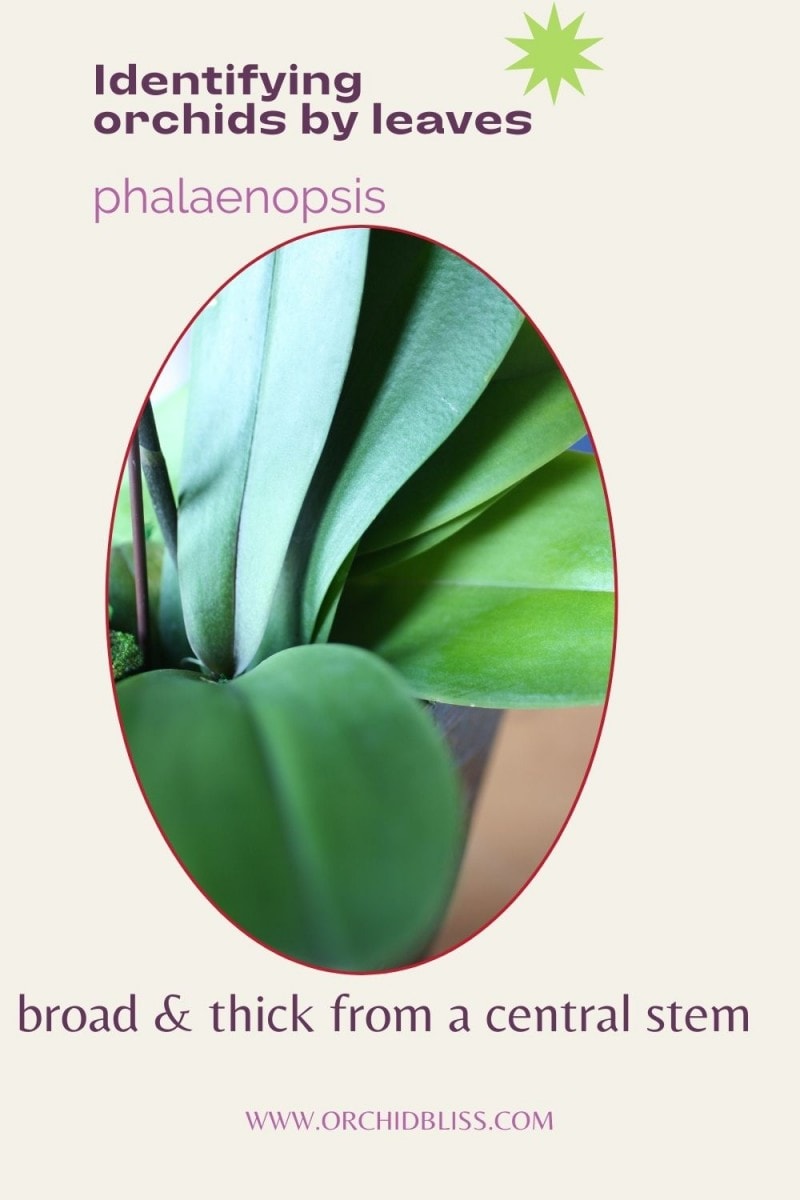
Vanda
Vandas don’t have pseudobulbs, but they’re easily identifiable thanks to their idiosyncratic leaf shapes. The leaves come in three different types: terete leaves are thin, pencil-shaped, stiff, and tapering with a circular cross-section.
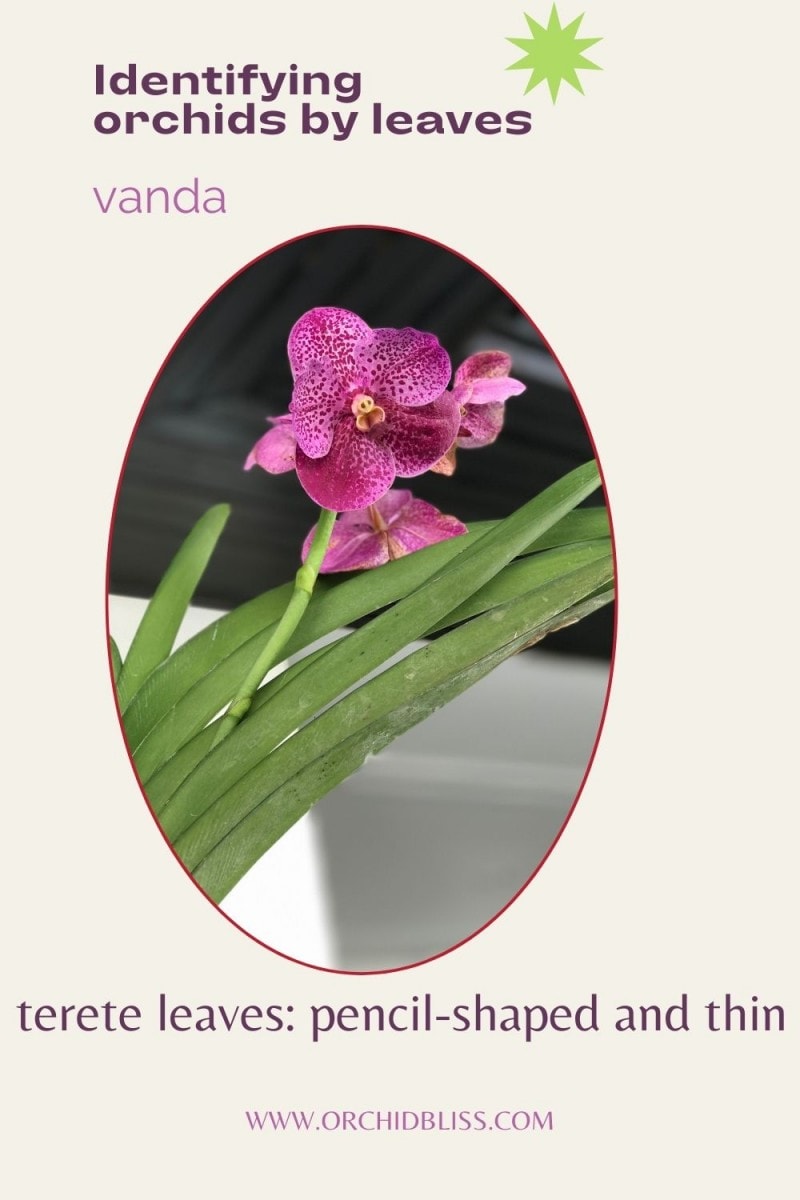
Strap leaves are narrow, v-shaped, flat, and leathery. They’re somewhat tapered but don’t have a completely round cross-section.
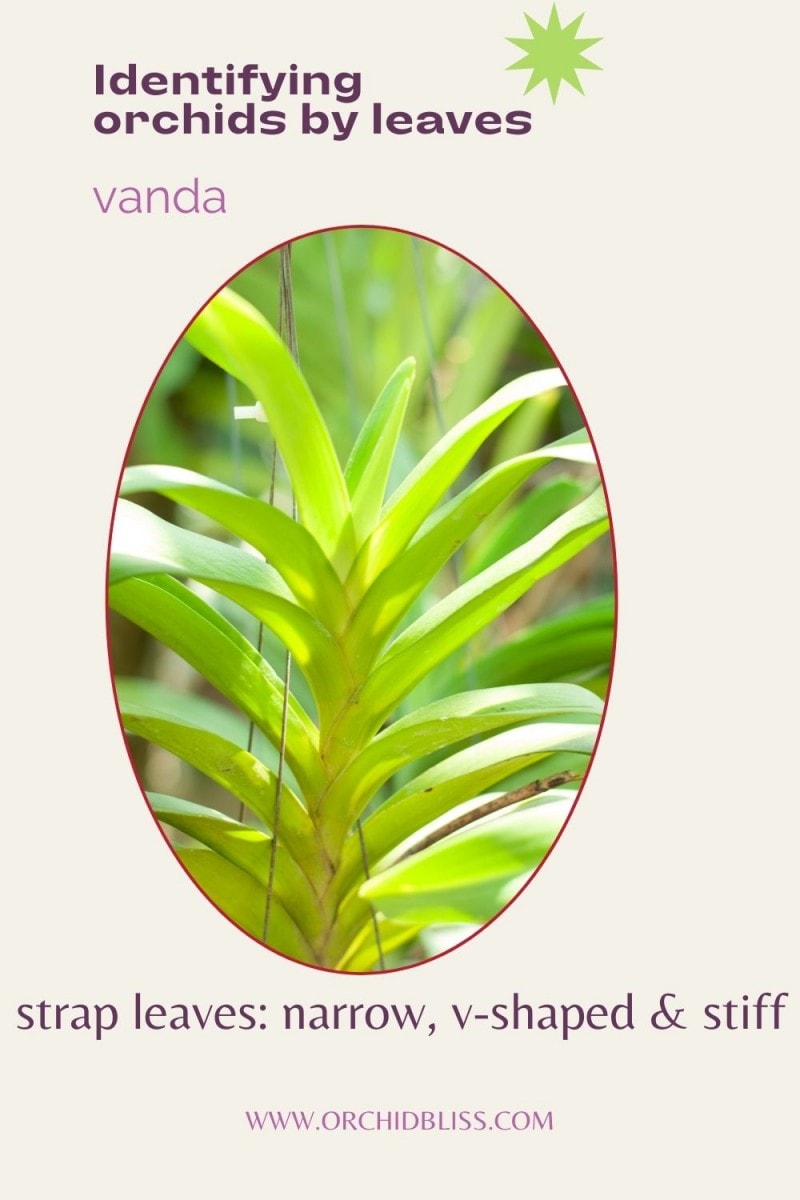
Semi-terete leaves are a combination of terete and strap leaves.
Stems grow from the leaf base, and due to their monopodial growth, all new growth comes from the plant’s crown. The stems develop from the leaf base. The fragrant flowers are mostly yellow with brown spots, with 8 to 10 blossoms on each spike. However, red, green, burgundy, and white flowers aren’t uncommon. The colors are uniquely intense and include the rare blue color among orchids (Vanda coerulea).
Vandas can vary in size from a few inches to 6 feet (1.83 meters). The flowers can be less than an inch up to four inches, and each stem may have up to 15 flowers. The aerial roots are long and rambling that allow the plant to attach to the mounting or trees. They often reach four feet below the vanda plant.
Due to their magnificent flowers, Vandas are among the most popular genus in the market.
How to Identify Orchid Flower Spikes
Spikes are the long stems on which flowers bloom. Orchids are different in terms of spike location and number and the number of flowers that grow on each spike.
To tell the difference between a root and a spike, you need to be patient. Over time, when they grow longer, you can determine if it’s a spike for sure. By carefully observing the growth, you’ll see either of these situations:
If the growth has rounded tips, it’s the root. When it grows, a protective substance covers it and gives it a white or silver color. In some species, the roots curl up over the pot’s edges.
On the other hand, spikes are greener with flat, uniform, and mitten-shaped tips. When they grow to their full length, they don’t change their color and remain green.
In some orchids, spikes emerge from the plant’s center, while in other species, they come out of the space between two leaves.
How to Identify Wild Orchids
You can identify wild orchids by looking at their flowers, leaves, stems, pseudobulbs, and other features. So, the criteria we outlined for cultivated orchids can help identify wild orchids, too.
But there’s one more thing to look at when you try to identify a wild orchid:
Consider the Natural Habitat
While you may see wild orchids in flower shops, you’re more likely to come across a species if you’re an avid nature lover.
Wild orchids widely vary depending on the region and climate. For example, in tropical areas, there are extraordinarily large exotic flowers in a whole range of colors, from orange to brown, or from pure ghost white to maroon. You can find the most spectacular orchids in the tropics.
Look at the land where the orchid grows. In Europe, where wet grassland is more common, orchids typically exist in pale colors like pastel shades of lilac and purple, with elegant stems.
Some of them are really scarce and only exist in preserved lands. They usually grow in chalk and limestone lands.
The number of wild orchids is overwhelmingly vast. So, it’s impossible to provide a complete list of them. For example, in Florida alone, there are 120 native orchid species identified.
Common Wild Orchids
Let’s talk about the most common types of orchids typically found in the wild and open terrains.
Orchis Ustulata
This orchid’s common name is burnt orchid and doesn’t grow for more than 20 centimeters (7.87 inches). It gets its name because the buds’ tips look as if they’re burned. The buds are initially maroon, but when they open, they gradually turn pink. You can find them on grassland with chalk and limestone soil. It’s native to Europe and considered an endangered species.
The terrestrial plant has thick roots and sometimes takes 10 to 15 years to grow the first stem. The leaves are 3-9 centimeters (1.18-3.54 inches) with noticeable veins, and the stem can grow up to 28 centimeters (11 inches).
Each plant can produce a maximum of 70 flowers densely packed into a cylindrical form. The crimson-spotted flowers have a strong scent that’s similar to honey.
Dactylorhiza Fuchsia
Also called the common spotted orchid, it grows in different kinds of open land. The flowers have a pure white or deep pink color with spots and streaks, dashes, or loops on them.
The lips are three-lobed with lateral lobes larger than the middle one. Bracts also appear along with the flowers on the spike. The leaves are also spotted. They can reach up to 25 inches (60 centimeters) in height.
The densely flowered spike is conical at first but then becomes cylindrical. Some variations are strongly scented and attract moths during the day. The leaves have dark spots on them and have narrow, oval shapes.
Listera Cordata
The lesser twayblade orchid is small with red-brown flowers, rarely growing over 15 centimeters (5.91 inches) high. It has only one pair of leaves on a single stem that is red and clasped between the two glossy leaves. It often goes under heather. You can find it in wet heaths covered by moss. Compared to other types of orchid, the flowers are plain and simple with red-green or purple-brown colors.
Orchis Anthropophora
It’s also called man orchid because it looks like a human figure with yellow or red lips as the man’s torso and limbs and the petals as the head. Limestone grassland is its natural habitat.
The leaves form a basal rosette that reaches 2 inches (5 cm) and grows from a 6-centimeter (2.36-inch) tuber (swollen roots). The central spike produces up to 50 small and stemless flowers in green and yellow-green colors. The labellum has purple streaks and marks.
Ophrys insectifera
Also known as the fly orchid, it’s a slender perennial plant that grows up to 2 ft (60 cm) high. The flowers bloom from May until July. The leaves are narrow and upright. The flower spike can bear one to ten flowers with yellow-green sepals. The petals are dark brown or black, similar to an insect’s antenna. The lips are long and narrow with a dark lobe. There are two shiny depressions on the lip and a blue or grey patch that resembles insect wings.
Amerochis
It has succulent leaves and a fleshy rhizome, growing up to 33 centimeters (13 inches). The stem’s base sprouts from the middle of a single leaf and can grow up to 11 centimeters (4.33 inches) long. The inflorescence consists of the spike and leaf-like growths called bracts, which grow on the stem’s top section.
Each plant can produce a maximum of 18 blooms with three sepals and three shorter and narrower petals than the sepals.
Calypso Bulbosa
This plant is also known as Venus’s slipper or fairy slipper and has red, purple, or pink flowers with dark purple spots. The name comes from Greek and means cover since the plant likes sheltered areas. It can grow up to 14 centimeters (5.51 inches) and has corms that look like a bulb (hence the name bulbosa).
Goodyera
Due to the unique shape of flowers, the Goodyera genus’s wide range of species is also called ‘lady’s tresses.’ With more than one hundred species, they grow almost anywhere globally, except for Africa and South America.
The leaves are creeping with spiral-shaped, resupinate flowers that are small and white. The rhizome is fleshy and bears leaves arranged in a rosette-like pattern and covered with sticky hairs. The lip has a small pouch surrounded by overlapping sepals and petals.
Isotria
There are two common types of isotria: isotria medeoloides and isotria verticillata.
Isotria medeoloides is also called little five leaves. It’s one of the rarest species found in temperate regions of North America.
The plant’s stem is waxy grayish green that reaches up to 25 centimeters (9.84 inches). The leaves are also greyish green and grow up to 8 cm (3.15 inches) long on their distinctive whorl. The petals are yellowish with green streaks and reach 1 to 2 centimeters (0.39 to 0.79 inches) in length.
Isotria verticillata is also native to the eastern parts of North America. Commonly known as the purple five-leaf orchid, it’s terrestrial and has rhizomes that grow underground. The lower side of waxy green leaves is a bit whitish, and the yellow-green flowers grow up to 4 inches across.
Conclusion
The most common types of orchids are cattleyas, oncidiums, Angraecum, paphiopedilum, and phalaenopsis. They all have distinctive features in terms of flower and leaves size, shape, and coloring.
Wild orchids are also recognizable based on their flowers, leaves, spikes, and roots. Some of them are native to specific parts of the world, and some are more widespread. By carefully inspecting their features, you can hopefully identify them and take care of them the way they require.
If you are ready to learn more, download my free cheat sheet to see where to cut the orchid flower spike after blooms have faded to trigger re-blooming. Click here, for the cheat sheet.
Related Posts:
24 Beautiful Dendrobium Orchids That Are Easy to Grow at Home
Hey, Windowsill Orchid Growers, This Is for You
Read13 Surefire Ways to Bloom and Grow Cattleya Orchids
If you thought Cattleyas were too tricky, think again
ReadSources
- Reptome: Orchid Identification – What Kind of Orchid Do I Have?
- Plantsam: Orchid Identification
- American Orchid Society: First Identify Your Orchid
- Longwood Gardens: Identifying Orchids
- Orchid Fetish: Cattleya Orchid Species Care
- Everything Orchid: Vanda Orchids

